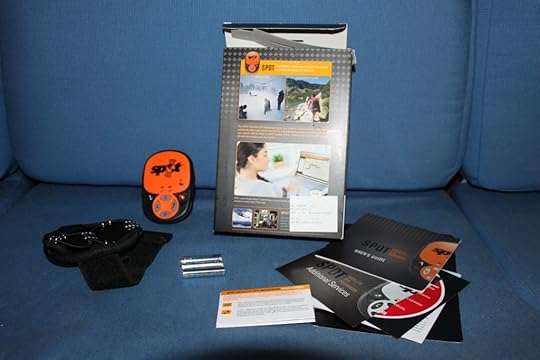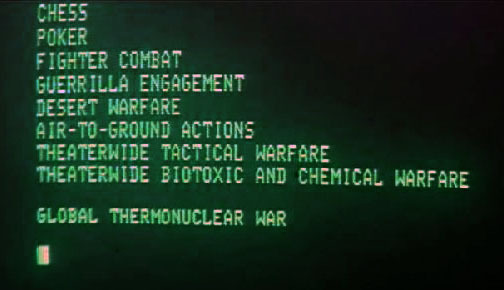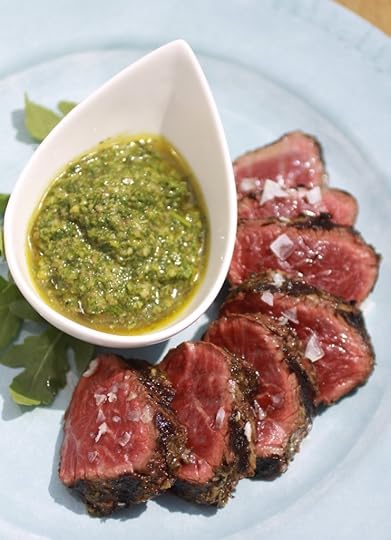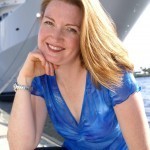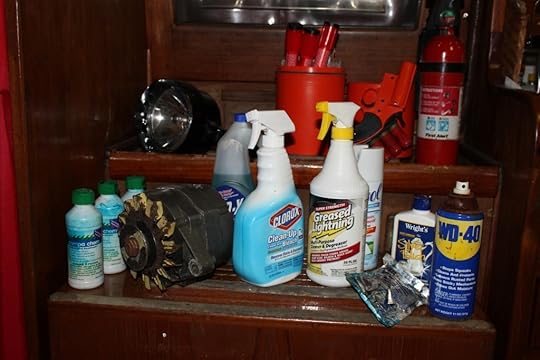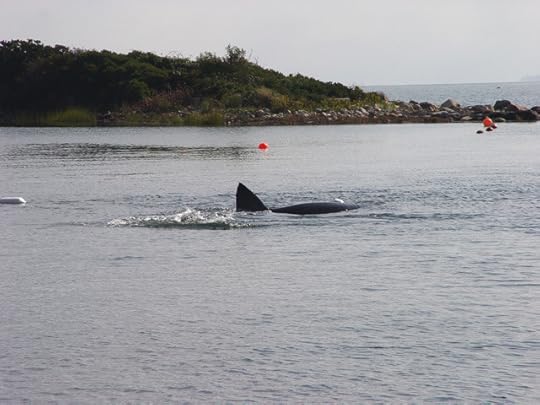Mike Jastrzebski's Blog, page 89
June 5, 2011
From Rags to Riches: May sales.
By Mike Jastrzebski
I sold 1167 books in May– 533 copies of The Storm Killer and 634 copies of Key Lime Blues (A Wes Darling Mystery). 225 copies of The Storm Killer were sold at .99 cents and 274 copies of
and 634 copies of Key Lime Blues (A Wes Darling Mystery). 225 copies of The Storm Killer were sold at .99 cents and 274 copies of  Key Lime Blues were sold at .99 cents. All of the other copies were sold at $2.99.
Key Lime Blues were sold at .99 cents. All of the other copies were sold at $2.99.
As expected, once I raised the price of the books to $2.99 sales quickly fell back to the pre-.99 cents level. I decided this was okay because even though my sales had increased with the .99 cent price point, I was losing money. I needed to sell six times the number of books to break even and although I was close to that number with The Storm killer, I was only selling about twice as many copies of Key Lime Blues.
I had to make a choice whether I wanted to show more sales or make more money–earnings won out over sales, however, after three weeks I lowered the price of The Storm Killer back to .99 cents.
I don't know why, but so far this month Key Lime Blues is outselling The Storm Killer by a margin of about three to one. Up until around the end of 2010 The Storm Killer outsold Key Lime Blues. The Storm Killer has received twice as many reviews (40) as Key Lime Blues (21) and has a higher overall review rating. That's 4.7 stars out of 5 for The Storm Killer and 4.3 stars for Key Lime Blues.
I'm hoping that when Dog River Blues, the sequel to Key Lime Blues, comes out late this summer it will help push sales on all of my books upward. I'll let you know if it does.
I have also started advertising with Goodreads, but it's too early to say how that's working. I'll post on that at the end of the month.
I have sold just over 8175 books between both titles since last July. I'm certainly not getting rich at this, but considering that I started out on this journey hoping to sell 50 books a month of each title and make an extra couple hundred dollars a month, I can't complain.
Share on Facebook
June 2, 2011
Spot On
by Christine Kling
For one who professes simplicity and a desire to de-clutter my life, I sure have been on a spending spree lately. My boat splashed back into the water on Tuesday, and since then I have bought 125 feet of anchor chain, new sheets for the new (to me) used headsail, a replacement solar vent for my main hatch, and a portable 12V fan for the upcoming long hot days at my computer. I've had repair work done to my dinghy and I've bought umpteen little bits, screws and washers. Even before going into the yard, I bought a new VHF radio, fancy replacement blades for my wind generator, and a new SPOT Satellite GPS Messenger. But it's not that I've suddenly become this materialistic person. Rather, there is a rule of thumb concerning what it costs to maintain a sailboat, which is supposedly 5-10% of the value of the boat. I've owned TALESPINNER for six years now, and I haven't been anywhere near to that formula. So what I'm doing is playing catch up.
Sometimes when I get new equipment, particularly if it is technology stuff, I admit I get a little cocky. No problem, I say to myself. I'll barely have to read the directions, and I'll be up and running in minutes. Ha! Not so with my new SPOT Satellite GPS Messenger – it took me an hour in the manual before I even figured out how to turn it on.
So what is this SPOT device? The box tells you it "gives a line of communication with friends and family when and where you want it, and emergency assistance when and where you need it." It isn't meant to replace a real EPIRB (emergency position-indicating radio beacons) but it does perform some of the same functions. It struck me as a good cheap (however, I found out it is not so cheap) back-up plan now that my EPIRB is in its last year of battery life. This little device can send emails or text messages to up to 10 different individuals, and it can call allow you to send an SOS distress call. In addition, it permits you to set up a web page to show your current location as plotted on Google Maps.
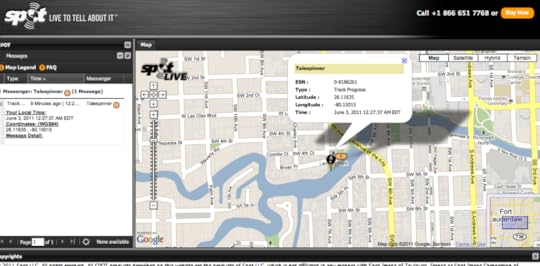
My current location at Cooley's Landing Marina
It does this using GPS navigation and satellite communications so you can contact home from anywhere on the face of the earth. I figured that sounded like a pretty good deal, so I bought one at the rebate price of $99.00.
First of all, the documentation that comes with the device doesn't even show a picture of the buttons on the face of the thing until page 9. They want you to get right in and sign up for that subscription. I knew a subscription was necessary, but I didn't realize how much it was going to cost, and there was no information on the box to explain this. Trying to select the subscription options before I really understood what the device was supposed to do made that task doubly difficult. I finally had to read the 25 page manual cover to cover to figure out how to register, activate it and determine if the device had actually locked on to a GPS signal. This all seemed to take forever. Their website for registration gave little more information and was glacially slow. Then, whenever I changed my mind, it cleared the form and made me start again.
And it was certainly a little eery trying to figure out what to write in the messages labeled HELP that would be emailed and texted to my loved ones in the event I needed to push that button. "Dear son, I'm treading water at the following position. . . "
So here are the options I signed up for and the prices for a one year subscription:
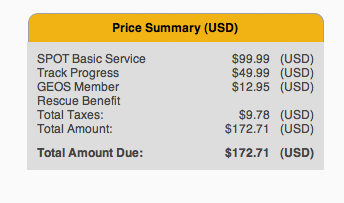 Everyone must subscribe to the SPOT Basic Service. I added the Track Progress to get the Google Maps function for more than just the ten friends and family you can have on your list. The GEOS Member is a sort of insurance against creating a false Search and Rescue and having the government ask you to pay for it. I declined the Rescue benefit which means they will call Towboat US for you. And, of course, there are taxes. That is a pretty steep price once you factor in the $99.00 you paid up front.
Everyone must subscribe to the SPOT Basic Service. I added the Track Progress to get the Google Maps function for more than just the ten friends and family you can have on your list. The GEOS Member is a sort of insurance against creating a false Search and Rescue and having the government ask you to pay for it. I declined the Rescue benefit which means they will call Towboat US for you. And, of course, there are taxes. That is a pretty steep price once you factor in the $99.00 you paid up front.
Would I have bought the SPOT if I had realized what it was going to cost? Probably. I really like the idea of letting friends and family watch my sailing tracks on the map. That will make a great addition to my website — a new type of location-based social media. Instead of playing Where's Waldo? you can play Where's Christine? and the answer will be SPOT on.
Fair winds,
Christine
Share on Facebook
Back to writing basics…
My first computer wasn't technically even a computer. It was a WYSE Unix Terminal that logged onto a remote server. It was 1992, I was working at Sun Microsystems at the time, in the very un-technical position of switchboard operator/receptionist. Computers were starting to become more common in the workplace, but I had zero computer skills and it wasn't part of my job description. There was a Unix terminal at my desk, but I was never expected to actually use it, which was fine with me. My purpose was to route phone calls, take messages, greet visitors with a smile and provide a 'professional front office appearance.' It wasn't a very taxing job. I spent much of my day sitting alone with the potted plants adorning the lobby, and when things were slow it could get downright dull. On the plus side, I had plenty of time to read, enough to burn through a novel or two a week. And on one particularly slow day, having polished off yet another mystery, I asked one of the technical support guys if he had anything laying around for me to read. He passed me a Unix manual, chuckling to himself as he headed back to his desk.
I read that manual cover to cover, and I taught myself Unix. Perhaps not true Unix, but enough for me to start playing around with that terminal I'd been deliberately ignoring. It was actually rather fun. Page by page I devoured that manual and followed the examples, fascinated by the way I could manipulate the softly glowing green letters suspended within the screen's inky blackness. It wasn't long before I discovered that magical terminal was connected to something called the internet. Back in those days going online wasn't exactly point-and-click: it took some working knowledge of Unix and VI Editor. Needless to say, I was amused to find myself in online conversations with techies at places like AT&T, MIT and NASA. And when I remarked that a system like that would be wonderful for writing at home, my manual-donating techie friend at Sun even bestowed me with a mothballed terminal, a keyboard and a remote log-on to the server for my personal use. I had my first word processor!
It's been years since the days of that old terminal, (centuries, if you calculate it in technology time) and many computer keyboards have passed beneath my hands. Operating systems have come and gone, screens went from monochrome to color to LED/LCD. Where once I dialed up on a modem like the one in War Games, now there's WIFI and Bluetooth. Mice came to be, then evolved past wires to touchpads and touchscreens. It leaves me to wonder where technology will be in years to come. And last week, as my laptop, still running XP, began to act a bit too flaky I decided it was time for a newer machine.
So here I sit, writing this now on a sleek new laptop with all the current bells and whistles. It's truly amazing what computers have become, and equally amazing what the internet has grown into as well. But there's a downside to all these advances… they're potentially massive distractions. Which is why, when I write, I find it effective to go as back to basics as possible: I set the computer to emulate that old terminal. No fancy Word utilities or tabs and formatting ribbons. Just a plain, classic 'console' font in that familiar shade of green on a full screen of blackness. Writing, pure and simple.
Now, if only it was that easy to configure the distractions out of everything else in life!
Share on Facebook
June 1, 2011
No Time to Cook
It was during my second meal of toast with peanut butter that I realized, when you spend five hours a day with your fingers glued to the keyboard, staring at the screen in front of you, there is little time for cooking. I felt guilty leaving my post to spend the four seconds it took to push the lever on the toaster down to make my meal. As a chef on a yacht, I really should know better than to eat toast all day long.
My stomach growled and rebelled against the three cups of coffee I'd consumed on an empty stomach. I kicked myself for not having planned an easy meal or two for the days when I am writing. And vowed to create something a little more substantial for the next day.
I would imagine, it is the same with the time it takes to work on the boat projects. By the look of Christine's post on Friday, she has little time to cook as well. So, with the time constraints set by quitting your job, moving onto a boat and writing, I would like to offer this super simple lunch (or dinner…or really breakfast, too) that can be made in twenty minutes the night before, left to marinate and then grilled in five to ten minutes; allowing you the time and energy to spend the rest of the day writing or scraping the hull of the boat.
Grilled Hanger Steaks with Salsa Verde
4 hanger steaks (skirt or flank steaks work as well)
½ teaspoon sea salt
Salsa Verde:
1 lemon, zested and juiced
2 anchovies
¼ cup salted capers
3 cloves garlic, minced
1 shallot, diced
8 grinds of black pepper
1 bunch Italian parsley
¼ bunch basil
½ cup olive oil
Place ingredients for salsa verde in a food processor (or blender, or chop finely by hand), and puree to smooth. Marinate the hanger steaks in half the marinade for 2-24 hours.
Preheat the grill.
Sprinkle ½ teaspoon sea salt over the meat. Grill over high heat for 3 minutes each side. (the roundish shape will naturally produce 4 sides to grill) for medium-rare. Transfer meat to a cutting board and let rest for 5 minutes
Slice the steak into ½ inch slices. Serve with a side of salsa verde for sauce.
Serves 4
Victoria Allman,has been following her stomach around the globe for twelve years as a yacht chef. She writes about her floating culinary odyssey through Europe, the Caribbean, Nepal, Vietnam, Africa and the South Pacific in her first book, Sea Fare: A Chef's Journey Across the Ocean.
SEAsoned: A Chef's Journey with Her Captain, Victoria's second book is the hilarious look at a yacht chef's first year working for her husband while they cruise from the Bahamas to Italy, France, Greece and Spain; trying to stay afloat.
Victoria has been a columnist for Dockwalk, an International magazine for crew members aboard yachts for the past three years. Her column, Dishing It Up, is a humorous look at cooking for the rich and famous in an ever-moving galley.
She also regularly contributes tales of her tasty adventures to Marina Life, OnDeck Skipper and OceanLines.
You can read more of her food-driven escapades through her web-site, www.victoriaallman.com
Share on Facebook
May 30, 2011
Sharing A First Chapter
by Tom Tripp
From the Author — This is a bit of an experiment. I'm posting the first chapter of my book, The Fourth Wave, in this blog installment. There is a major revolution underway in the book publishing world and I thought it would be interesting to contribute in a tiny way by sharing my novel with our blog readers here. Actually, many novels used to be published a chapter at a time in magazines of the early and mid-20th century. This chapter may or may not change, based on feedback from readers, but this is how it stands today. The first two paragraphs are here in the blog post, and the link at the end of the post will take you to a pdf file of the full chapter.
—————
The Fourth Wave
Chapter 1
David Chen pulled hard on the kayak paddle, wincing as the blister on his right hand pulled open for what felt like the hundredth time in the last 45 minutes. At the end of every stroke, he turned the paddle and laid the throat of it against the hard edge of the kayak's gunwale, using it as a pivot and pulling inward on the handle. His motion transformed the paddle blade into a small rudder to compensate for the left-turning tendency of his right-handed stroke. He watched the bow of the kayak swing back in line with a tall pine tree on the small island ahead and judged that he had compensated sufficiently.
The wind was stronger now and what had begun as a mist drifting down from the gray clouds hugging the San Juan Islands was a harder, cold spray that stung his cheek. The lightweight kayak was being blown sideways now about a foot for every ten or twenty it moved forward and Chen had to keep adjusting his aiming point on the little island further to the windward in order to compensate. He looked off to his left to check on his girlfriend Annie, who was struggling even more than he was. She was concentrating hard now on keeping up her stroke, single-mindedly focusing on the island still a half-mile ahead of them. She didn't look at Chen, but he sensed the tension in the hard lines of her face. (Read the rest of Chapter 1 here)
—–
Copyright © 2011 by Thomas M. Tripp. All rights reserved.
Share on Facebook
May 29, 2011
Revisions
By Mike Jastrzebski
I'm not just talking about writing here, but also planning a cruise.
On the writing front I've been working hard at finishing up the revisions for Dog River Blues, the sequel to Key Lime Blues (A Wes Darling Mystery) . I'm on my fifth revision right now and my process goes something like this: first I go though and revise the revised original. (The book was written several years ago and revised several times back then.) Next my wife, Mary, edits the pages. I then go through and revise based on her suggestions, then I send it off to my critique group.
. I'm on my fifth revision right now and my process goes something like this: first I go though and revise the revised original. (The book was written several years ago and revised several times back then.) Next my wife, Mary, edits the pages. I then go through and revise based on her suggestions, then I send it off to my critique group.
The group does a thorough vetting of the pages I've provided to them, and then I go through and do another revision based on their suggestions. After that Mary edits the pages again and I make final changes based on her suggestions.
This works well for me because my critique group consists of three college English professors and a couple of other very picky writers. Mary is not a professional editor, but she did a fair amount of proofreading in her previous life as an investigator for the Minnesota Department of Health. She's picky, almost obsessive, about finding errors in my work, and she doesn't mind telling me when she thinks I'm wrong.
After I finish this rewriting process I plan to go through the book one more time before converting it into an eBook, then Mary and I will both read the finished proof before we let the book go live on Kindle, Barnes and Noble, and all other eBook venues, plus as a paperback through CreateSpace. It's a tough process, but I want my books to be as clean and well-written as possible.
Revising our cruising plans was just as hard and just as necessary. You see, we've decided to spend another hurricane season in Fort Lauderdale. As much as we wanted to leave this spring, trying to get all of the boat work done plus work on the book proved to be too daunting of a task.
We have finished enough of the work on the boat so that we feel confident we can get out of here no later than November, but you never know, that plan may have to be revised too. I hope not.
As a consolation prize I plan to bring out Dog River Blues by the end of July and another book, tentatively titled Weep no More, by the end of the year.
Now I need to spend a little time revising this blog before I post it. You know what they say, "Life's a bitch, then you revise your expectations." At least that's what I say.
Share on Facebook
May 26, 2011
Raising the waterline
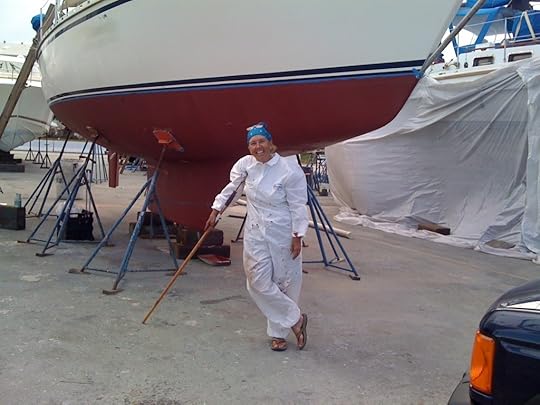 I just finished painting the first coat on the bottom this afternoon, day four of life on the hard and the lovely midnight treks down the ladder and through the shadowy hulls to the ladies room. My boat used to have another white stripe above the bottom paint, but I had to raise the waterline this time around.
I just finished painting the first coat on the bottom this afternoon, day four of life on the hard and the lovely midnight treks down the ladder and through the shadowy hulls to the ladies room. My boat used to have another white stripe above the bottom paint, but I had to raise the waterline this time around.
There are certain markers in life that alert you to the fact that weight has become a problem. Bloat has set in. A little over two months ago I realized that I had two entire sets of clothing in two different sizes and the bigger size was starting to feel tight. I was not about to start buying a third wardrobe, nor did I have room on my boat for all those clothes, and I wanted to get back to a leaner me — so I went on a serious diet. I lost the weight, chucked the big clothes and figured I had succeeded.
Until I got here to the boatyard. My body was not the only thing in my life suffering from serious bloat. When the slings lifted TALESPINNER out of the water on Monday, the slime line was crawling up my boot stripe. I had a bloated boat. Tuesday morning, I made the call to raise the waterline one inch. It's the books and the tech gear and all the stuff that I carry around to keep my life going. But then, I decided to check all the thru-hull fittings, so I pretty much had to make every locker on the boat vomit up its contents into the main salon. It was then (after the fact) that I realized that raising the waterline was the equivalent to buying that extra set of clothes. It's a done deal now, but what I really needed to do was to put my boat on a serious diet. It was time for the boat to shed some pounds.
But in a way, putting the boat on a diet is even more difficult than it was to put myself on a diet. The problem with chucking gear off the boat is figuring out what to do with the old stuff.
And lots of this stuff dates back to the boat's former owner. Like how about the fact that for six years I have been carrying around an old alternator that he took off the engine? It's all rusty inside and one very heavy hunk of metal. Do you just throw that in the garbage? What about seventy-five feet of old anchor chain that could be regalvanized, but it is in three twenty-five foot pieces with joining links, and I just want to get new chain. Or what about the flares that expired in 2008? I've now bought new ones. How do I dispose of the old ones? I've also decided that I am only going to use biodegradable products in the gray water that I discharge overboard, so what do I do with the nearly full bottles of cleaning supplies I no longer want?
By the time I leave Fort Lauderdale, I hope that I personally will have experienced a makeover to a leaner, meaner me and the boat, too, will be cleaner, greener, sleeker and lighter. But I still will not be done.
I also have a bloated manuscript. The new book clocks in at over 150,000 words or over 500 pages. I'm not just going to raise the waterline. You know your book is too long when you ask some beta readers to read it, but they can't seem to finish it. In about three weeks when I find a nice quiet anchorage in the Abacos, it will be time to put my book on a serious diet. Losing the weight was hard and figuring out what to keep and what to throw away (and how to throw it away) on the boat was even harder. But the most difficult job of all is going to be figuring out how to give liposuction to a bloated book.
Wait, I'm getting ahead of myself. Anybody need a rusty can of WD-40?
Fair winds!
Christine
Share on Facebook
The truth about multi-tasking…
The other day Mike discussed the problem of sharing a blog and how on occasion one of us may unknowingly and unintentionally touch on a topic remarkably similar to something a fellow writer had been planning to post. I suppose within this group of writers/boaters, we find ourselves faced with similar tasks and challenges in our day to day lives. But there's the flip side of this, and one of the advantages to a group like us sharing a blog: the ability to consider a situation from multiple viewpoints.
My daughter often refers to me as 'Goldfish', which is a playful jab at my abysmally short attention span and questionable memory. Playful, but completely accurate. My brain is constantly on the go, often awash in words and ideas, but rarely does it pause to take stock of things at hand. As a result I'm frequently quite forgetful and easily distracted. Perhaps it's a result of an overactive imagination, maybe it's the lingering effects of a nasty head injury or a combination of the two, but either way focus and recall are not my strong points. That's part of why I love to write… once things are written they can't be forgotten. Ideas become permanent and it clears my head, leaving space for fresh thoughts to occupy. And I write lists - lists of to-do's, lists of ideas, lists of lists. Without these lists, I'd get little done. I've given up even trying to multi-task – I focus on a single task, complete it, and only then do I move on to the next. Goldfish aren't known for their multi-tasking skills.
There was a time I tried to find a better system. I had much to do, and surely there had to be some way to better utilize my time. But the thing is, multi-tasking is a myth. Just watch anyone walking with a cell phone to their ear. They drift along at half-speed, weaving slightly, occasionally bumping into obstacles, and they're not getting anything done efficiently. Studies have proven that when people multi-task, they aren't truly doing multiple tasks simultaneously – they're rapidly switching between various tasks at the same time, never truly focusing on a single purpose – and as a result they're not doing any single task well. These days, with all our fancy gadgets and high-tech devices we're all supposed to believe we can do it all, and we can do it faster and better. Everything is multi-this and high-speed that, but the bottom line is if you want to do something right, sometimes you just have to slow down, take a breath, and focus. Especially when you're working with a sewing machine or trying to get a boat prepped for that cruise. There will be time to write once things are done.
Share on Facebook
May 24, 2011
Bring In The Shark
In an earlier blog, CE wrote about how the movie Jaws benefited from the technical problems the film crew experienced with the mechanical shark, her point being that the high level of suspense was enhanced by the fact that movie viewers spent more time imagining the shark than actually seeing the Hollywood creation.
That movie, filmed on a coastal island of my home state, left a great impression on me. The book, too. In fact, I still remember the first time I saw someone reading Jaws. It was my junior year in high school. I recall looking over and seeing the paperback in the hands of a fellow student. I was all about boats, I was all about the water, and I couldn't figure out why this cute girl in a pleated skirt had a book with a shark on the cover. But it didn't take long to figure things out. Word of mouth and marketing thrust Jaws forward faster than Lady Gaga riding a cruise missle.
A half dozen years later I spent a few summers on Martha's Vineyard and when I'd ride the road up island I'd always take notice of the derelict boat in Menemsha Pond left behind by the film crew. And I'd learn more about Peter Benchley and his personal reflection that Jaws called attention to Great Whites in ways that encouraged over-fishing and over-stated fear.
My own experience with sharks, other than sand sharks, remained quite limited. My wife reminds me that we saw some big sharks when we swam off the boat in the British West Indies, and I remember getting out of the water once in North Bimini when, swimming by myself, I saw the large roaming shadow of what may or not have been a bull shark. Nevertheless, when it came to penning a Steve Decatur mystery, a great white worked its way into the story.
And now, as summer approaches, I'm presented with the option of pitching my book as a beach read. Given this, I thought that maybe it's time to consider the extent to which I should highlight the shark in an effort to sell books. I was giving this some consideration when mother nature nudged me a bit.
Check this out:
The same story made the papers in Boston and around New England. But the UK's Daily Mail? Now that's reach.
What do I say? Bring in the Shark!
Share on Facebook
Ego Vs. Bank Account
By Michael Haskins
I closed out my scheduled book signing "Free Range Institution" Thursday of last week at the North Palm Beach Library. Diana Kirby from the library introduced me to the small, but enthusiastic gathering.
It has been a long two-month road trip and the turn out was always less than expected, even at the Los Angeles Times Festival of Books. I spent Thursday & Friday in Deerfield
Beach since I had to attend the Saturday board meeting of the Florida chapter of Mystery Writers of America.
Friday gave me time to think over the book signings. The crowds were less, but each store had books for me to sign that were sold from its website or to a store regular that couldn't make it. That was good. Usually about half those in attendance bought books.
I am not going to get rich or even meet costs from book signings. What I hope is that name
recognition will build and maybe by book four or five the sales will be better and attendance at signings will grow.
While on the road, I checked my Kindle sales for "Chasin' the Wind," "Tijuana Weekend" and short stories. The sales increased after my ad in Kindle Nation in March. In April I
had more than $300 due in my back account and the sales are continuing to look good in May.
The $100 ad certainly paid for itself and then some.
My next book, "Car Wash Blues," is due out in August 2012. I am working on the fourth in my series, "Stairway to the Bottom," and hope to be finished by the end of the
year. I am seriously thinking of publishing it on Kindle.
Having the hardback edition of my book on my bookshelf or held in my hands is certainly a great feeling. It boosts my ego but not my bank account! The last I looked gas stations and super markets didn't accepted boosted ego in payment for overpriced gas and/or food.
I have two Mick Murphy novels I wrote in Mexico ("Tijuana Weekend" being the third, but is already on Kindle) and I am thinking of beginning to rewrite them in 2012 for Kindle. I also have a short story or two in mind and might write one of them in hopes that The Saturday Evening Post will accept it. Of course, I always hope Ellery Queen Mystery Magazine will be interested in my short stories. The Post wants stories less than 5,000 words, while EQMM lets me write up to 10,000 words.
If my Kindles sales average$250 a month for a year, it doubles what my publisher's advance. Also, if I own the book that is on Kindle I can have Amazon's CreateSpace issue
trade paperback copies for sales, so my ego will be somewhat appeased.
Mike has said, in writing on this blog and in talking to me, that the more books available on Kindle it improves your chance for more sales. So, if I add the two "lost novels" written in Mexico to my Kindle/CreateSpace lists, my sales should be better than $250 a month. Maybe double?
Before I can do anything, I need to finish "Stairway to the Bottom," and get back into the
daily writing mode. After two months away it is not as easy as it should be.
By the end of this week I will be back to writing in the morning, reading in the early afternoon, and editing what I've written before dinner – I hope. My evenings will be set
aside for the battle between ego and checking account. Am not sure which one I hope wins, but one of them will.
Share on Facebook

